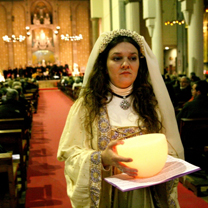Cant de la Sibil·la
Imatge destacada

Until the Council of Trent caused its disappearance in the 16th century, the Cant de la Sibil·la, the Song of Sibyl, was widespread throughout Europe. Considered a pagan ritual, performances of this piece of religious theatre that forsees the coming of the Messiah and the end of the world were forbidden in churches, and it only survived intact in Majorca. In 2010, UNESCO declared the Majorcan representation a Masterpiece of the Oral and Intangible Heritage of Humanity. Durng the 19th century in Catalonia, this liturgical drama began to be recovered, thanks to the interest of certain folkorists.
Performed before the Missa de Gall, midnight mass on Christmas Eve, the Cant de la Sibil·la stars a boy or a woman dressed as a prophetess, a fortune teller from the pagan world, with a silk cloak and a sword in their hand . The song, which has lyrics translated into Catalan in the 18th century and which is often sung a cappella, originated from a Mozarabic melody.
There are four churches in Barcelona where you can hear this mediaeval chant. The Basilica de Santa Maria del Mar was the first to recover the song and it has been performed here in the traditional style, accompanied by a choir, since 1948. In the Sant Gervasi i Protasi parish in the Bonanova district, there have been recitals since 1998, normally sung by the Majorcan singer Maria del Mar Bonet. It has been performed in the Catedral de Barcelona since 2009 and from 2008 it has also been heard in the Santa Maria de Gràcia parish, where the song is accompanied by the choir of the Orfeó Gracienc.



